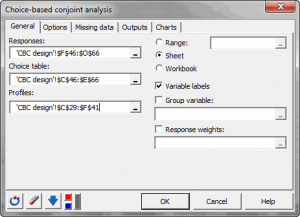CHOICE-BASED CONJOINT ANALYSIS
Choice-Based Conjoint analysis is used in marketing to detect important product attributes from choices of product profiles. Run CBC in Excel with XLSTAT.

PRINCIPLE OF CHOICE-BASED CONJOINT ANALYSIS (CBC)
Conjoint analysis is a comprehensive method for the analysis of new products in a competitive environment. This tool allows you to carry out the step of analyzing the results obtained after the collection of responses from a sample of people. It is the fourth step of the analysis once the attributes have been defined, the design has been generated, and the individual responses have been collected.
In the case of CBC models, individuals must choose between selections of profiles. Thus, a number of choices are given to all individuals (we will select a product from a number of products generated).
Analysis of these choices is made using a multinomial logit model based on a specific conditional logit model.
If order to validate your model, you can perform holdout cases. Moreover, if a respondent doesn’t want to make a choice, XLSTAT can consider this case in the analysis.
RESULTS OF A CHOICE-BASED CONJOINT ANALYSIS
As part of the Choice-Based Conjoint analysis, which is different from full profile conjoint analysis, we obtain aggregate utilities -- one utility for each category of each variable associated with all the individuals.
XLSTAT-Conjoint analysis software proposes to include a segmentation variable that will build separate models for each group defined by the variable. In addition to utilities, conjoint analysis provides the importance associated with each variable.
If you have performed holdout cases, rlh (root likehood) index is computed to evaluate model quality.


analyze your data with xlstat
Included in